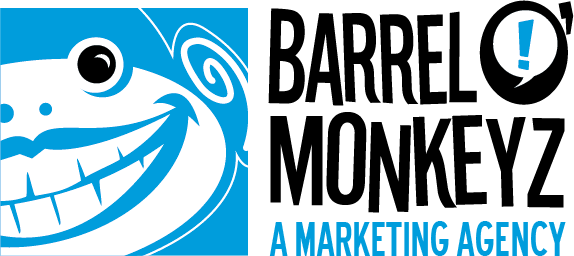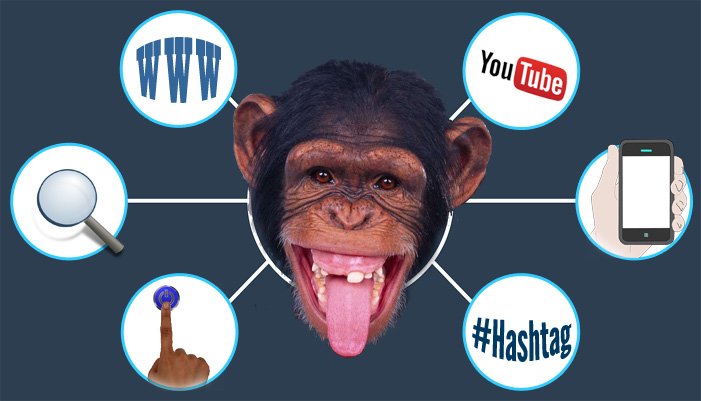The transition away from what’s known as “traditional marketing”—what we, back in the day, simply called “marketing”—is accelerating. Newspapers and magazines large and small are forgoing print editions in favor of online versions; and even billboards are getting digital makeovers. In its place, the ever-evolving world of “digital marketing” is firmly taking root. First came websites, email marketing, and banner ads, and now we have interactive social networking and platforms such as Instagram, Facebook, and a host of other technologies that are increasingly mobile, customizable, and interactive.
But just because the “tools of the trade” are changing, does that mean the tenets of successful marketing are changing as well?
To this King Monkey’s finely tuned marketing ears, the phrase “traditional marketing” conjures images of tangible items such as running ads in newspapers and magazines, on billboards, TV, and radio; printing brochures and business cards—and even holding special events at a physical venue such as a place of business.
Utter the words “digital marketing” and my brain is suddenly awash with thoughts of smart phones, YouTube videos, Facebook, and millions of other online venues ranging from e-commerce websites to a plethora of social media platforms.
Again, while today’s marketing tools certainly differ, is what’s important for success radically different?
Nowadays, as is/was the case with traditional marketing, your main concerns remain:
- Identifying your target audience,
- Creating a brand story/message that compels your audience to buy your product or service (vs. a competitor),
- Finding the right channels to reach your audience, and
- Delivering your product in a way that keeps customers coming back and wanting to refer you to others.
For example, as a satisfied customer “back in the day,” you might have called a friend on the phone or demonstrated face-to-face how your shiny, new “what’s-it” was all you hoped it would be and more. Nowadays, you might post a video of that same shiny, new “what’s-it” on YouTube and recommend it to hundreds of friends via Facebook, all in a matter of minutes. Yes, it still amounts to what is essentially a word-of-mouth referral, but the efficiency and reach of your referral is exponentially greater.
The Power of Digital Marketing
Therein lies the power of digital marketing: the opportunity for marketers to share their messages with large audiences over multiple channels, and then to have those audiences share their own experiences of the brand with ever-increasing numbers of others in an ongoing dialogue/process that creates buzz and top-of-mind awareness.
Better yet, digital marketing can often better target greater numbers of people at a fraction of the cost of traditional marketing. Place a print ad in the local daily, and you’re hoping that it finds the eyes of your target audience on that particular day and that those reading it are motivated to buy at that particular time. It’s really hit or miss. Digital marketing, however, gives your message “legs” and a better chance to find the eyes of a target buyer.
“You. Can. Break. The. Internet”
Set Yourself Up for Digital Marketing Success
Companies that know themselves and know their customers best will enjoy the greatest success in the evolving mix between digital marketing and traditional. The ability to adapt to changing technology and consumer trends is critical. One place every business can start, regardless of size, is to know the company’s mission (what you’re all about and the brand promise you bring to the marketplace) and then develop a brand message that engages target buyers regardless of the medium.
Paul June is King Monkey of BARREL O’ MONKEYZ, a full-service digital media and marketing group specializing in more creativity, ideas, and fun for action sports marketing, sportswear marketing, sports product marketing, active lifestyle consumer products, health product marketing, and brands in San Diego and Southern California.


Greetings from Ohio! I’m bored at work so I decided to check out your
site on my iphone during lunch break. I really like the
info you provide here and can’t wait to take a look when I get home.
I’m shocked at how quick your blog loaded on my cell phone ..
I’m not even using WIFI, just 3G .. Anyways, fantastic site!
thank you!
Good post however , I was wondering if you could write a litte more on this topic?
I’d be very thankful if you could elaborate a little bit further.
Thanks!
Thanks!
I do not even know how I finished up right here, but
I assjmed this put up wass great. I do not recognize who you
might be however certainly you are going to a well-known bloggsr when you are not
already. Cheers!
Hi there, I discovered your website by way of
Google while searching for a similar topic, your website
goot here up, it appears good. I have bookmarked it in my google bookmarks.
Hello there, juust change into alert to your weblog thhrough Google, and located that it’s really
informative. I am going to watch out forr brussels. I will
appreciate for those who proceed this in future.
Numerous other people shall be benefited fromm yoiur writing.
Cheers!
Good info. Lucky me I recently found your website by accident (stumbleupon).
I have book marked it ffor later!